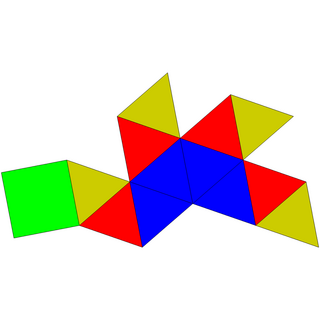Gyroelongated square pyramid
| Gyroelongated square pyramid | |
|---|---|
 | |
| Type | Johnson J9 – J10 – J11 |
| Faces | 12 triangles 1 square |
| Edges | 20 |
| Vertices | 9 |
| Vertex configuration | |
| Symmetry group | |
| Properties | convex, composite |
| Net | |
 | |
In geometry, the gyroelongated square pyramid is the Johnson solid that can be constructed by attaching an equilateral square pyramid to a square antiprism. It occurs in chemistry; for example, the capped square antiprismatic molecular geometry.
Construction
The gyroelongated square pyramid is composite, since it can be constructed by attaching one equilateral square pyramid to the square antiprism, a process known as gyroelongation.[1][2] This construction involves the covering of one of two square faces and replacing them with the four equilateral triangles, so that the resulting polyhedron has twelve equilateral triangles and one square.[3] Any convex polyhedron in which all of the faces are regular is a Johnson solid, and the gyroelongated square pyramid is one of them, enumerated as , the tenth Johnson solid.[4]
Properties
The surface area of a gyroelongated square pyramid with edge length is:[3] the area of twelve equilateral triangles and a square. Its volume:[3] can be obtained by slicing the square pyramid and the square antiprism, after which adding their volumes.[3]
File:J10 gyroelongated square pyramid.stl It has the same three-dimensional symmetry group as the square pyramid, the cyclic group of order eight. Its dihedral angle can be derived by calculating the angle of a square pyramid and square antiprism in the following:[5]
- the dihedral angle of an equilateral square pyramid between two adjacent triangles, approximately
- the dihedral angle of a square antiprism between two adjacent triangles, approximately , and between a triangle to its base is
- the dihedral angle between two adjacent triangles, on the edge where an equilateral square pyramid is attached to a square antiprism, is , for which by adding the dihedral angle of an equilateral square pyramid between its base and its lateral face and the dihedral angle of a square antiprism between two adjacent triangles.
Applications
In stereochemistry, the capped square antiprismatic molecular geometry can be described as the atom cluster of the gyroelongated square pyramid. An example is [LaCl(H2O)7]4+2, a lanthanum(III) complex with a La–La bond.[6]
References
- ↑ Timofeenko, A. V. (2010). "Junction of Non-composite Polyhedra". St. Petersburg Mathematical Journal 21 (3): 483–512. doi:10.1090/S1061-0022-10-01105-2. https://www.ams.org/journals/spmj/2010-21-03/S1061-0022-10-01105-2/S1061-0022-10-01105-2.pdf.
- ↑ Rajwade, A. R. (2001). Convex Polyhedra with Regularity Conditions and Hilbert's Third Problem. Texts and Readings in Mathematics. Hindustan Book Agency. doi:10.1007/978-93-86279-06-4. ISBN 978-93-86279-06-4. https://books.google.com/books?id=afJdDwAAQBAJ.
- ↑ 3.0 3.1 3.2 3.3 Berman, Martin (1971). "Regular-faced convex polyhedra". Journal of the Franklin Institute 291 (5): 329–352. doi:10.1016/0016-0032(71)90071-8.
- ↑ Uehara, Ryuhei (2020). Introduction to Computational Origami: The World of New Computational Geometry. Springer. p. 62. doi:10.1007/978-981-15-4470-5. ISBN 978-981-15-4470-5. https://books.google.com/books?id=51juDwAAQBAJ&pg=PA62.
- ↑ "Convex polyhedra with regular faces". Canadian Journal of Mathematics 18: 169–200. 1966. doi:10.4153/cjm-1966-021-8.
- ↑ Chemistry of the Elements (2nd ed.). Butterworth-Heinemann. 1997. p. 917. ISBN 978-0-08-037941-8.
See also
External links
 |
